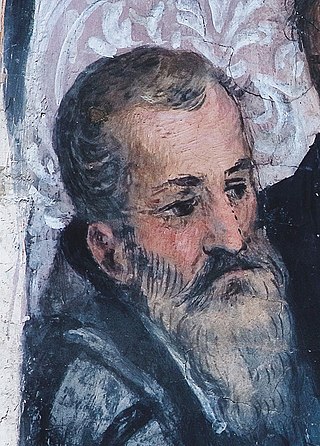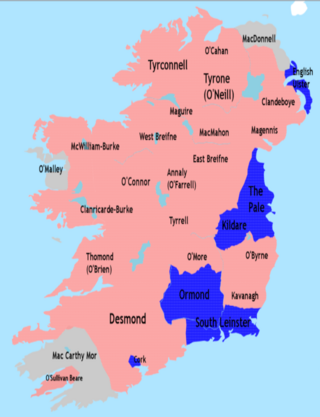
Hugh O'Neill, was an Irish Gaelic lord, Earl of Tyrone and was later created The Ó Néill Mór, Chief of the Name. O'Neill's career was played out against the background of the Tudor conquest of Ireland, and he is best known for leading a coalition of Irish clans during the Nine Years' War, the strongest threat to the House of Tudor in Ireland since the uprising of Silken Thomas against King Henry VIII.

Sir Turlough Lynagh O'Neill was an Irish Gaelic lord of Tír Eoghain in early modern Ireland. He was inaugurated upon Shane O’Neill’s death, becoming The O'Neill. From 1567 to 1595, Sir Turlough Luineach O'Neill was leader of the O'Neill clan, the most powerful family in Ulster, the northern province in Ireland. He was knighted in 1578.

Shane O'Neill was an Irish chieftain of the O'Neill dynasty of Ulster in the mid-16th century. Shane O'Neill's career was marked by his ambition to be the O'Neill—sovereign of the dominant O'Neill family of Tír Eoghain. This brought him into conflict with competing branches of the O'Neill family and with the English government in Ireland, who recognised a rival claim. Shane's support was considered worth gaining by the English even during the lifetime of his father Conn O'Neill, 1st Earl of Tyrone. But rejecting overtures from Thomas Radclyffe, 3rd Earl of Sussex, the lord deputy from 1556, Shane refused to help the English against the Scottish settlers on the coast of Antrim, allying himself for a short time instead with the MacDonnells, the most powerful of these settlers. Shane viewed the Scottish settlers as invaders, but decided to stay his hand against them with hopes of using them to strengthen his position with the English. However, tensions quickly boiled over and he declared war on the Scottish MacDonnell's defeating them at the Battle of Glentaisie despite the MacDonnells calling for reinforcements from Scotland. The Scottish MacDonnells would later assassinate Shane O'Neill and collect the bounty on his head.
Conn Bacagh O'Neill, 1st Earl of Tyrone, was king of Tyrone. In 1541 O'Neill travelled to England to submit to Henry VIII as part of the surrender and regrant policy that coincided with the creation of the Kingdom of Ireland. He was made Earl of Tyrone, but his plans to pass the title and lands on to a chosen successor Matthew were thwarted by a violent succession dispute that led to another son, Shane O'Neill, emerging triumphant.
The Earl of Tyrone is a title created three times in the Peerage of Ireland.

Sir Phelim Roe O'Neill of Kinard was an Irish politician and soldier who started the Irish rebellion in Ulster on 23 October 1641. He joined the Irish Catholic Confederation in 1642 and fought in the Wars of the Three Kingdoms under his cousin, Owen Roe O'Neill, in the Confederate Ulster Army. After the Cromwellian conquest of Ireland O’Neill went into hiding but was captured, tried and executed in 1653.

The Nine Years' War, sometimes called Tyrone's Rebellion, took place in Ireland from 1593 to 1603. It was fought between an Irish confederation—led mainly by Hugh O'Neill of Tyrone and Hugh Roe O'Donnell of Tyrconnell—against English rule in Ireland, and was a response to the ongoing Tudor conquest of Ireland. The war began in Ulster and northern Connacht, but eventually engulfed the entire island. The Irish alliance won numerous victories against the English forces in Ireland, such as the Battle of Clontibret (1595) and the Battle of the Yellow Ford (1598), but the English won a pivotal victory against the alliance and their Spanish allies in the siege of Kinsale (1601–02). The war ended with the Treaty of Mellifont (1603). Many of the defeated northern lords left Ireland to seek support for a new uprising in the Flight of the Earls (1607), never to return. This marked the end of Gaelic Ireland and led to the Plantation of Ulster.
The title of Count of Tyrone has been used by two European branches of the O'Neill family to claim affiliation with the O'Neill Earls of Tyrone in the Peerage of Ireland. Romance languages, such as French, Spanish, and Portuguese, do not distinguish between earls and counts, but use the same word for both; when these titles have been translated into English, they are generally rendered Count.
Hugh McShane O'Neill was an early modern Irish nobleman and rebel associated with the McShanes of Glenconkeyne and Killetra. This group was also called the "Wild Clan Shanes of Killetragh" or the "McShane-O'Neills". His parentage is disputed however he is claimed by some as being either a grandson or great-grandson of Conn O'Neill, 1st Earl of Tyrone, and Gearoid Mór Fitzgerald, 8th Earl of Kildare, and of the primary line of the O'Neill of Tyrone clan.
Shane O'Neill, 3rd Earl of Tyrone was the youngest son of Hugh O'Neill, Earl of Tyrone.

Clandeboye or Clannaboy was a kingdom of Gaelic Ireland, comprising what is now south County Antrim, north County Down, and the barony of Loughinsholin. The entity was relatively late in appearance and is associated partly with the Gaelic resurgence of the High Middle Ages. The O'Neill Clandeboy who reigned in the territory descended from Hugh Boy O'Neill, a king of Tyrone. His descendants took advantage of the demise of the Earldom of Ulster during the latter 14th century and seized vast portions of territory. Clandeboye's main seats of power were Shane's Castle and Castle Reagh.
The title Baron of Dungannon in the Peerage of Ireland was associated with the first creation of the title of Earl of Tyrone.

Tír Eoghain, also known as Tyrone, was a kingdom and later earldom of Gaelic Ireland, comprising parts of present-day County Tyrone, County Armagh, County Londonderry and County Donegal (Raphoe). The kingdom represented the core homeland of the Cenél nEógain people of the Northern Uí Néill and although they ruled, there were smaller groups of other Gaels in the area. One part of the realm to the north-east broke away and expanded, becoming Clandeboye, ruled by a scion branch of the O'Neill dynasty. In one form or another, Tyrone existed for over a millennium. Its main capital was Dungannon, though kings were inaugurated at Tullyhogue Fort.
Colonel Gordon O'Neill, was an officer in King James II's Irish army who fought at the Siege of Derry, the Battle of the Boyne, and the Battle of Aughrim for the Jacobites.
Matthew O'Neill, 1st Baron Dungannon, was an Irish aristocrat. He was accepted by Conn O'Neill as his natural son. Matthew was challenged by his half-brother Shane O'Neill over the succession to the Earldom of Tyrone and was murdered by some of his supporters.
The Burning of Dungannon took place in June 1602 when Hugh O'Neill, Earl of Tyrone, abandoned and set fire to Dungannon, the traditional capital of the O'Neills. It marked the beginning of the final stage of Tyrone's Rebellion when the Earl became a fugitive, before his sudden reprieve the following year.
Sir Arthur O'Neill or Sir Art O'Neill was an Irish soldier and landowner. He was part of the O'Neill dynasty, which was the most powerful Gaelic family in Ireland at the time. He was the son of Turlough Luineach O'Neill, the head of the O'Neill dynasty until 1595. He was the second son of Turlough, but his eldest brother Henry O'Neill died in 1578. At times he had a strained relationship with his father, and offered his support to Turlough's rival Hugh O'Neill, Earl of Tyrone. When Tyrone succeeded Turlough as head of the O'Neills and began Tyrone's Rebellion, Arthur offered tacit support to his distant cousin.
Sir Turlough McHenry O'Neill is known for having been killed together with his father, Henry, fighting for the crown in O'Doherty's Rebellion and for being the father of Sir Phelim O'Neill, who started the Irish Rebellion of 1641.
Brian Ó Néill, Baron Dungannon was an Irish aristocrat of the Elizabethan era. He was part of the O'Neill dynasty, a Gaelic family in Ulster.
Dungannon Castle was a castle at Dungannon, County Tyrone, Northern Ireland.





